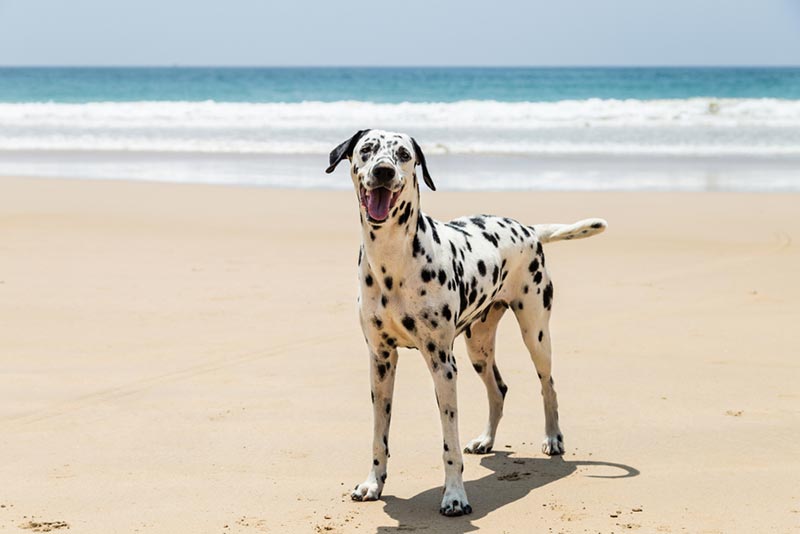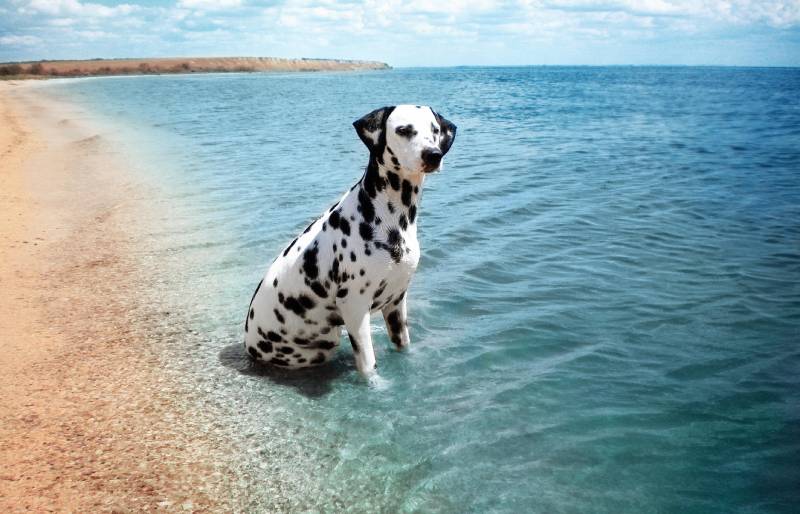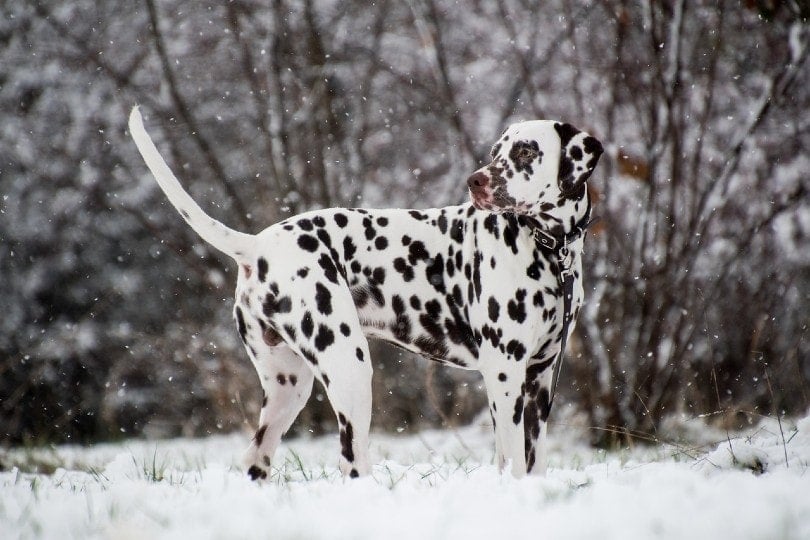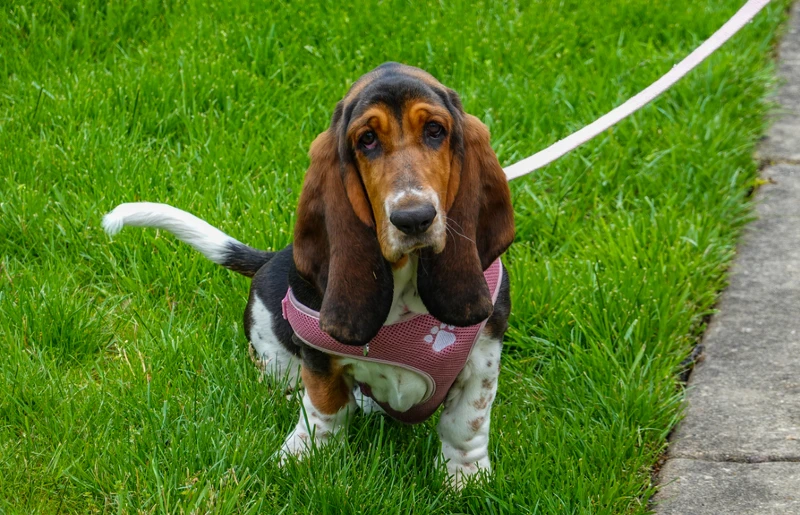How Long Do Dalmatians Live? Vet-Reviewed Lifespan, Data & Care

By Misty Layne
Updated on

Click to Skip Ahead
Dalmatians may be most well-known from the movie “101 Dalmatians” and for being the mascot of firehouses everywhere, but they also make excellent pets. But if you’re adopting one of these cute pups, you’ll want a good idea of how long they live, so you can determine the cost of owning one. As medium to large-sized dogs, Dalmatians tend to live 11 to 13 years, which is fairly normal for this size dog.
But there are factors that can shorten a Dalmatian’s life, particularly health issues. Here’s a look at some of the most common features of Dalmatian dogs and their life stages!
What’s the Average Lifespan of a Dalmatian?
As stated, Dalmatians live to be between 11 and 13 years of age. This is pretty average for a medium to large-sized dog, but because of certain health issues the Dalmatian is prone to, their lifespans can be slightly shorter than other medium to large-sized breeds. However, your Dalmatian should live 11 to 13 years with proper care.
Why Do Some Dalmatians Live Longer Than Others?
1. Nutrition
A dog’s lifespan can be increased if they are given the complete and balanced nutrition they need to stay healthy. This means a high-quality dog food that contains excellent protein from good sources and all the vitamins and minerals a Dalmatian requires. Dog food should also be low in fat, as Dalmatians can have a tendency to be slightly overweight, but it will depend on their individual level of activity and life stage. It’s crucial to speak to your vet before choosing a food for your dog or changing it.
One other thing necessary in a dog food for your Dalmatian is that it is low in purine. Dalmatians are genetically1 predisposed to urate bladder stones.2 And because these stones can lead to pain and discomfort when passing urine, or even a urinary blockage, you want to do what you can to prevent them.

2. Size
Since we’ve said a couple of times that Dalmatians are medium to large-sized dogs with a medium to large-sized dog’s life expectancy, you’ve probably guessed that the size of your dog affects how long they live.
You can’t do anything about the size of your Dalmatian, of course—they are the size they are—but you can be aware of how a breed’s size affects the length of their life.
3. Breeding History
Dalmatians were once bred to perform athletic jobs, such as running beside a firehouse’s horse-drawn carriage. Being bred for athleticism kept them from being prone to certain health issues. But that changed with the release of “101 Dalmatians”.
That movie encouraged a surge in Dalmatian adoption, which led to more lax breeding protocols. And every time a new version of “101 Dalmatians” is released, it’s followed by high demand for Dalmatians. When demand is high, more in-breeding occurs, and more breeding is done without health testing on dams and sires. This makes potential genetic health issues more prevalent, which could shorten the Dalmatian’s lifespan and general health. Genetic factors are something you cannot influence, and it shows the importance of responsible breeding and getting a dog from a verified source, where the parents and grandparents have been health tested.

4. Healthcare
Dalmatians are prone to a number of health problems, some of which can shorten their lifespans. Here are a few of those.
Deafness: Dalmatians are prone to deafness, and that deafness makes these dogs more liable to be injured or killed. A lack of hearing means dogs can’t hear cars coming or respond to voice commands you give them. This means taking extra care to keep your Dalmatian safe when you’re out and about with them.
Urate Stones: As mentioned previously, Dalmatians are more likely to get urate stones, which is why a diet low in purine is so vital. And because these stones can lead to blockages in the urinary tract, they can result in kidney failure and death. Signs of urate stones include inappropriate elimination, trouble urinating, blood in urine, pain, and dribbling urine.
Copper Storage Disease: Some Dalmatians will experience a build-up of copper in their liver, resulting in chronic hepatitis. This disease is more likely to be found in middle-aged and senior Dalmatians and, if left untreated, can end in liver failure. If you notice a loss of appetite, lethargy, or jaundiced eyes and skin in your Dalmatian, they’ll need to get to the vet as soon as possible.
The 3 Life Stages of a Dalmatian
Puppy: 0–12 Months
This period is the most crucial when it comes to socializing and training your dog. Destructive and inappropriate behaviors are much simpler to correct when your dog is still a puppy, and correcting them will keep your pet safer in the long run. This is also a period where you can help ensure a longer life for your Dalmatian by getting them the necessary vaccinations and starting them on parasite control medications. Speak to your vet about the proper care for your puppy.
Adult: 12 months–8 years
Most medium to large-sized dogs continue growing until they are closer to 15 months of age as a general rule, but for some larger individuals, this is closer to 18 months. The young adult stage of a dog’s life begins when a Dalmatian has reached the weight and height standard for adult Dalmatians. This means no more growth for your dog! This is also a period where you can keep your pet in good health by giving them high-quality dog food with proper nutrition and keeping them well-exercised and mentally stimulated. And don’t skimp on vet visits! Make sure your dog gets to all their required vet visits.

Senior: 8+ years
When your Dalmatian reaches their senior years, you’ll need to closely monitor their health. This is a period when routine visits to the vet are useful to help catch any disease early. Many illnesses can be managed successfully with medication and diet, and catching them earlier rather than later only improves the chances of your pet having a longer and good-quality life.
How to Tell Your Dalmatian’s Age
When examining a Dalmatian puppy, the most common way to figure out your dog’s age is by checking their teeth, which is best done by your experienced vet. Pups that are 3 weeks old or younger likely won’t have teeth, but those between 3 and 6 weeks of age can have tiny, sharp baby teeth. Permanent teeth will appear from 3.5 to 4 months and look healthy and white until about one year.
If you see minimal wear and tear on teeth, the dog is at least older than one; if teeth have become slightly yellowed, your dog may be a little bit older. By the age of 5 and up, you’ll see more staining on the teeth and teeth that have been worn down some, so they’re not as sharp. But be mindful that a dog’s teeth are not always an accurate presentation of their age, and it’s easy to make a mistake, as it also depends on their chewing habits, diet, routine dental hygiene, and preventive care. Dogs that chew a lot can have worn out teeth at a much younger age, while senior dogs should have healthy teeth if well cared for with regular brushing.
If you can’t tell how old your Dalmatian is from their teeth, have your vet check; they should be able to give you a reasonable estimate. Alongside teeth, examining the dog’s demeanor, level of activity, coat, eyes, and pads may be useful in getting an idea of their age, while there are also commercial DNA tests available to tell you how old your dog may be.

Conclusion
Dalmatians have a normal lifespan for a medium to large-sized dog, as they can live between 11 and 13 years of age. Several factors can affect how long a Dalmatian lives, particularly genetics and health issues, but there are some steps you can take to help them live longer and healthier lives with routine vet checks and preventative care. And if you adopt a Dalmatian but aren’t sure of their age, there are several ways you can get a rough estimate (your vet should gain a pretty good idea of your pet’s age using various methods and taking a good look at your dog, even if you can’t).
The most important thing to remember, though, is that with getting a dog from a verified and reputable breeder that performs regular health checks of the dams and sires, and with proper care, your Dalmatian should lead a full, healthy life! But there are always unfortunate situations that are out of our hands, so always speak to your vet if you feel your dog isn’t quite right, as early diagnosis and treatment can mean a world of difference.
Featured Image Credit: Iren Key, Shutterstock














